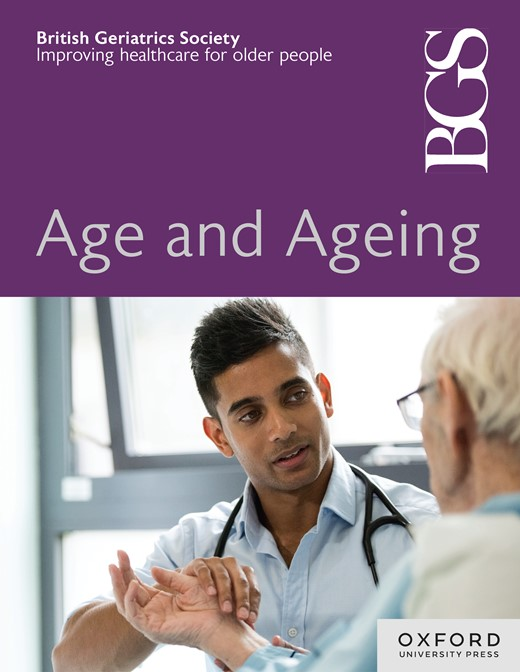老年病专科病房患者排便情况及相关工作人员知识回顾
IF 7.1
2区 医学
Q1 GERIATRICS & GERONTOLOGY
引用次数: 0
摘要
背景 尿失禁是体弱的一个常见且令人头疼的特征(NCPOP,2012 年),在老年病综合评估 (CGA) 中会对其进行常规检查。它会影响生活质量、行动能力、跌倒和整体护理需求。患者通常在入院期间就会出现尿失禁,而医护人员对尿失禁状况(CS)的了解以及为改善尿失禁状况所做的努力往往很有限。我们试图在病房中探讨这些问题。方法 我们在三间老年病专科病房开展了一项点流行率研究,查看了病历并采访了病房护士。研究对象包括六周内年龄超过 65 岁的患者。我们制作了一份表格,记录了患者目前和入院前的CS情况,以及尿失禁用品的使用情况。我们还对护理人员对CS的认识进行了调查。结果 共纳入 104 名患者(57% 为女性,平均年龄 81 岁)。总体而言,34 名患者(32.7%)患有尿失禁(UI),其中 22 名患者(64%)在入院后出现了新的尿失禁。27名(25.7%)患者插入了导尿管,其中大部分(23;85%)为短期使用。近一半的患者(46;44.2%)患有大便失禁(FI),其中 74% 是入院后新出现的大便失禁。总体而言,19 名患者(18%)有双重失禁。此外,还对患者的大小便失禁情况进行了复查;57 名患者(54%)穿着全包裹式大小便失禁服,28 名患者(27%)穿着拉拉裤。有 26 人(25%)尽管大小便失禁,但仍穿着失禁服。只有 28 人(27%)在触手可及的地方有呼叫铃。对护士的意识进行了检查,85 名护士(81.7%)意识到了患者的失禁情况,15 名护士(14.4%)只是部分意识到。所有病例均查阅了护理交接文件。有 35 名患者(33%)的 CS 影响了他们的出院计划。结论 在我们的队列中,UI 和 FI 的发生率很高,并且在入院期间进一步增加。医护人员的知识水平令人满意,但在改善CS方面所做的努力却不尽如人意。因此,我们为临床医护人员举办了一次教育课程,将尿失禁评估纳入 CGA。此外,每个病房都任命了尿失禁问题宣传员。本文章由计算机程序翻译,如有差异,请以英文原文为准。
A Review of Patient Continence and Related Staff Knowledge on Specialist Geriatric Wards
Background Incontinence is a common and troublesome feature of frailty (NCPOP 2012), routinely examined in a comprehensive geriatric assessment (CGA). It can impact on life quality, mobility, falls and overall care needs. Patients often develop incontinence during hospital admission and staff knowledge of continence status (CS) and efforts to drive improvements are often poor. We sought to explore these issues on our wards. Methods We conducted a point prevalence study, reviewed medical charts and interviewed ward nurses on three specialist geriatric wards. Patients >65y over a six-week period were included. We developed a proforma and recorded current and pre-admission CS, and use of continence wear. Nursing staff awareness of CS was also explored. Results 104 patients (57% female, mean age 81y) were included. Overall, 34 (32.7%) had urinary incontinence (UI), of whom 22 (64%) developed new UI since admission. 27 (25.7%) patients had a urinary catheter inserted, most (23; 85%) for short-term use. Almost half (46; 44.2%) had faecal incontinence (FI), of which 74% was new FI since admission. Overall, 19 patients (18%) were doubly incontinent. Continence wear was also reviewed; 57 (54%) were in full wrap-around continence wear, 28 (27%) in pull-ups. 26 (25%) wore continence wear despite being continent. Only 28 (27%) had a call bell within reach. Nursing awareness was examined, 85 nurses (81.7%) were aware of their patient’s CS, and 15 (14.4%) were partially aware. In all cases, nursing handover documents were consulted. For 35 patients, (33%) CS impacted on their discharge plan. Conclusion Rates of UI and FI were high in our cohort and further increased during hospital admission. Staff knowledge was satisfactory but suboptimal efforts were made to improve CS. Consequently, an education session was delivered to clinical staff to embed continence assessment into CGA. Additionally, continence advocates have been appointed to each ward.
求助全文
通过发布文献求助,成功后即可免费获取论文全文。
去求助
来源期刊

Age and ageing
医学-老年医学
CiteScore
9.20
自引率
6.00%
发文量
796
审稿时长
4-8 weeks
期刊介绍:
Age and Ageing is an international journal publishing refereed original articles and commissioned reviews on geriatric medicine and gerontology. Its range includes research on ageing and clinical, epidemiological, and psychological aspects of later life.
 求助内容:
求助内容: 应助结果提醒方式:
应助结果提醒方式:


